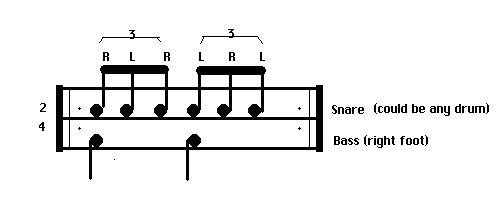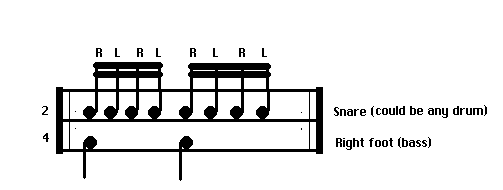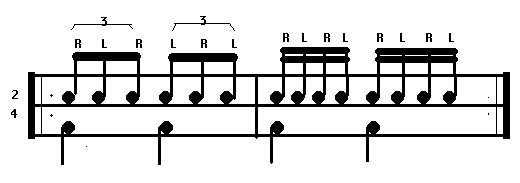


The March 97 issue of the Tempo Dispatch contained some of my best tricks and tips for building killer solos. But, just reading about solos won't do you much good. Follow those tips to the letter. I promise results! Soloing is an art form and it must come from within.
Nearly all my solo lessons will stress this same routine first, because it honestly works so well. I want to be certain that each and every student will try this . . . at least a few times. For most studennts, it will hopefully become an addiction that can produce a monster drummer in HALF the time with one-tenth the frustration. So, please bear with me as I re-cover a little bit of old-ground. (If you already understand this first part; jump on down to the sub-heading: "The Science of Rudiments and Soloing").
Input is the first secret!
Output is the second.
SECRET #1: GAINING 'INPUT':
Sure! We can set at a practice pad day and night for 20-years, repeating rudiments. It WILL help. But, it is the
absolute most boring way to learn. It also leads to a robotic drumming style that lacks creativity.
THAT'S NOT GOOD!
There is a much better way to build our chops and great solos simultaneously. NATURAL DRUMMERS have been discovering it since the early 1930s to the present day. If you are a creative thinker, you will discover it here.
First, we must hear the GREAT stuff in our head. The hands will find a way to play it, if only we can 'think' it. This is RULE #1 and it will lead to killer chops (limb coordination) and it will make it all happen in half the time with 10 times the FUN.
You shouldn't need to devote 1000 hours over a practice pad, getting your chops and your drummer-brain up to speed. You will grow to greatness the natural way if you'll try the following tips, religiously. They'll usually work, when all those recommended 1000 hours at the practice-pad may fail miserably.
INSPIRATION is half the battle! To my thinking; practice pads and boring rudiments are inspiration killers. When we (the students) are inspired, we'll play for the fun of it for hour after hour. Without the INSPIRATION, a 30-minute practice session will seem more like a million years and our progress will crawl at a snails-pace.
FIRST, we need to concentrate on the INPUT factor. You'll totally enjoy this, if there really is a drummer living inside you, struggling to be heard and felt.
The drummer-brain constantly absorbs rhythms and repeats them over and over until we incessantly begin banging and tapping on anything in sight. That's the reason we become drummers. We can't seem to make it stop! Why would we? It's a good thing, even if it does send the cat scurrying for the back door.
We can increase, develop and cultivate this NATURAL tendency to drum in a very easy way. Anyone who will state that drumming can't be studied and mastered SUBLIMINALLY, isn't a NATURAL drummer. Those who will tell you it's crazy are really saying it doesn't work for them. Guess what? They really aren't NATURAL drummers! Subliminal study does work and I'm about to prove it to you. (Or, at least those of you who really are natural drummers.) If this doesn't work for you, I'd like to suggest that you should worry about it, A LOT! You may be missing the NATURAL ingredient that will lead you to success. Keep an open mind. You can and will develop that natural soloing ability right here, right now. To your own surprise, you very well may discover that after a few weeks or months of this FUN habit, you will have mastered most of those boring rudiments automatically as well.THE FACT OF THE MATTER is this: whenever we aim a drumstick into the head of a drum more than once we have automatically done something technical (whether we have a fancy name for it or not). In sense, it's ALL math! No matter what we do, we are either playing some form of the (all important) note-value system and/or some form of the 400+ rudiments that currently exist world-wide. If we continue to slam, bang and thrash . . . it all takes shape automatically.
THE NEXT ARGUMENT is a logical one.
Some will ask: What about the left-hand (or weak hand)? Won't it lag behind?
The answer is potentially yes, but not necessarily. The best way to overcome that issue is to alternate our ideas.
In other words, as we discover a great original idea (leading with the good hand), we should try to reverse it. Play it backward, leading
with our weaker hand. As we experiment with all the possible combinations and variations of tonal variations around the kit, ALL the limbs
are developing naturally . . . while we have a GREAT time, expressing ourselvess' rhythmically. This same thing is true for the feet. We do try
to push the envelope constantly, playing as rapidly as possible, and experimenting with our ideas as much as possible.
DEVELOPMENT occurs naturally as the INSPIRATION and FUN factors remain at their peak. This is engrossing and fun. It is also precisely the way all 400+ rudiments came into existence in the first place. The ideas came first . . . THEN they were committed to paper and became (a very boring) educational-tradition. That rudimental tradition does have merit, (for those with little or no imagination and ideas of their own). I'm not in complete disagreement with it. It's just that there is another (less known) BETTER way.
AGAIN, I need to reiterate; the way to gain those ideas is to LISTEN FIRST . . . THEN PLAY, (in that specific order). Hang the practice-pad on a tree in the back yard and use it for target practice! TRY IT! FOLLOW THESE FUN, EASY STEPS:
To Clarify:
You'll (hopefully) get so caught-up in it, the neighbors may need to take legal action, to get you to stop. It goes with the gig! Smile a lot and STOP PLAYING when the police arrive.
Trust me! We do NOT have the right nor the freedom to play drum solos all night long when we live in congested areas.
NOW HEAR THIS!After ENJOYING this form of learning (daily) for a few months, grab a Rudiment Chart and work your way down the list, one-rudiment-at-a-time. To your shock and dismay, you may realize (as I and many of my students have done) that the rudiments are now very easy to play. You will have learned 80% of them the easy way . . . while having fun. The hardest part of rudiment study at that point, will be in memorizing the names of each rudiment.
Yes, the science of all this is important too, but the difference is, the above way is much easier, faster and a LOT more fun too. You'll practice longer because you will be having fun! It's that time-in-motion, that builds the chops, whether we are repeating paradiddles (on a practice-pad) or just having fun, expressing ourselvess' rhythmically.
REPEAT THESE WORDS! MEMORIZE THEM!"Your 'ears' will teach you 10-times faster and better than the eyes ever will."
The 'eyes' only create a log-jam. We are trained from birth to use the eyes as our primary learning tool. No one has ever taught US to use the 'ears'!
We're dealing with INVISIBLE sounds here . . . We don't SEE sound, we hear it. That's the issue and the argument! Use both learning techniques (eventually), but DO use the ears. Train them and they'll teach you 10-times faster.
So, what is all this about the science of solos and rudiments? (Now, we'll tackle this same topic, visually.)An analytical study of the average drum solo will show that two roll types tend to permeate most drum solos about 80% of the time. What are those two roll types?
![]() 8th-note triplets and 16th-notes.
8th-note triplets and 16th-notes.
It might help to study these two (note-value) rolls, in every form they may take. (Yep, this may be a little boring at first.)
What follows are a few suggestions that should help to get your own solo-engines primed and running if your hands and feet absolutely refuse to move on their own:
EIGHTH TRIPLETS:
![]() Listen and 'feel' the sound! Hear the 'Ba da da Ba da da' or 'trip-o-let, trip-o-let' in your head as you play them.
Listen and 'feel' the sound! Hear the 'Ba da da Ba da da' or 'trip-o-let, trip-o-let' in your head as you play them.
Strive to play the above roll pattern blazing fast! Watch TV and work with the above triplets on a pillow for long periods (like . . . several eventual hours). Watch the foot! The hard part is playing the bass along with that fourth note. Don't give up until you can do it at warp speed with no mistakes.
The most common thing that students will do wrong here is slip into 16th singles as they try to increase speed with 8th triplets. Avoid doing that by accident! It is a good maneuver, if you intend to do it, but be alert that it isn't happening by accident.
16TH SINGLES:
This is 16th Singles. Know the difference between 16th Singles and 8th triplets. Eventually, they will both dominate your bag of solo tricks . . .

![]() Listen. Build to (approximately) this speed . . . gradually.
Listen. Build to (approximately) this speed . . . gradually.

![]() Hear 8th triplets & 16th singles, intentionally mixed together.
Hear 8th triplets & 16th singles, intentionally mixed together.
Practice switching between 8th triplets and 16th Singles while maintaining a steady bass flow (or tempo).
Once you can keep a steady bass tempo and switch from one roll to the other, it will be time to climb behind the kit and begin to do your own thing. The sky is the limit! There are no mistakes! If you accidently get your arms and legs tied in a square knot . . . no problem! :>) It isn't a mistake until you lose or stop the beat flow. Really! It is easy to overcome this entangled dilemma! As your hands become confused . . . stop them but maintain the bass tempo . . . gather your thoughts for a few (bass) beats, then jump back in with a vengeance . . . continue on with another roll pattern.
What follows are *ONLY* suggestions. You may do these ideas in any order! Also, I should say . . . these are routines that may be manipulated with *ANY* roll type, including 8th triplets, 16th Singles, 16th Doubles, 16th Paradiddles, 16th triplets, Rogers (4-stroke) Ruffs and on and on:
You are playing your roll in a stream of notes and popping accents as you go. Now add a few super accented 'Power Rimshots'. Play with the tonal changes that can occur between accents and 'Power Rimshots'. The rhythmic possibilities are immense. Always seek to create new sounds and rhythms. Drop occasional 'Power Rimshots' with either hand. Let it flow and try to be creative!
Try to get the drums talking to each other as in a real conversation. This will include long and short pauses within the roll stream. Add dynamics as in a real conversation. There will be times when it sounds good to scream and times when you want to speak in a whisper. This injects feeling into the solo and it is fun.
Video: For almost all handheld devices and other browsers.
If you are the extremely studious type, you might look for books that focus on topics like triplet accents and cross-overs. There are even a few books out there that focus on single, double and paradiddle roll development.
I could fill reams of paper with practice routines in each category. You would see endless lines of a particular roll with added accents and complicated cross-over examples. You would see them . . . but would you study them? Most of us bore with that stuff real quick. I know I do! Try it! If it helps, that's great! If you bore as quickly as I do, don't worry! Just LISTEN and PLAY (in that order). It will accomplish the same end result, especially if you become totally addicted to the FUN that's involved.
Good luck! Burn 'em and keep it FUN!

![]()
Musical Time - Finite to Infinity:
Finite to Infinity:
Learn to easily jam and play music comfortably within any odd or even time signature. This material isn't currently taught in music-theory classes, yet it is simple enough for grade-school students. Discover more than 18 quintillion unique and different (modern music) song-beat structures.Discover the (lost) 500 year-old enigmatic secrets hidden within the current time-signature system. Seven short mesmerizing and easy-to-follow lessons will lead you quickly and easily towards (musical-time) guru status. You will learn to visualize (read, write or feel) the existence This should lead directly to the e-book.

This very informative little booklet will amaze you with hundreds of valuable tips and insider secrets! HOW TO: Purchase old/used drumsets for pennies and resell them for decent profits.